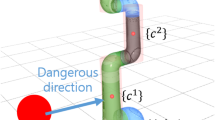Abstract
Avoidance of low performance configurations for robotic manipulators such as a singularity during physical human-robot interaction, is a crucial issue for effective cooperation. Performance constraints is a framework for online calculation of repulsive forces in the task space so that the robot does not allow the human to guide it to singularities. However, this repulsive field is configuration dependent and non-conservative, so energy can be injected to the system. In this paper we build upon performance constraints, utilizing a handling mechanism to monitor the energy flow of the system and dissipate the excessive energy. Moreover, the equivalent task space stiffness of performance constraints is determined and the appropriate damping is calculated for the desired dynamic behavior of the robot, so that no oscillations appear that can have a negative effect in the haptic feeling of the operator. This damping is the required minimum so that no over-damped behavior is observed, making the robot cumbersome to manipulate. The proposed method is verified experimentally in a redundant manipulator during physical interaction with a human.
Access this chapter
Tax calculation will be finalised at checkout
Purchases are for personal use only
Similar content being viewed by others
Notes
- 1.
Video from the experiment: https://youtu.be/OgLwfo6z1GU.
References
Carmichael, M.G., Liu, D., Waldron, K.J.: A framework for singularity-robust manipulator control during physical human-robot interaction. Int. J. Robot. Res. p. 027836491769874 (2017)
Chiaverini, S.: Singularity-robust task-priority redundancy resolution for real-time kinematic control of robot manipulators. IEEE Trans. Robot. Autom. 13(3), 398–410 (1997)
Di Vito, D., Natale, C., Antonelli, G.: A Comparison of Damped Least Squares Algorithms for Inverse Kinematics of Robot Manipulators. IFAC-PapersOnLine 50(1), 6869–6874 (2017)
Dietrich, A., Wu, X., Bussmann, K., Ott, C., Albu-Schaffer, A., Stramigioli, S.: Passive Hierarchical Impedance Control Via Energy Tanks. IEEE Robot. Autom. Lett. 2(2), 522–529 (2017)
Dimeas, F., Moulianitis, V.C., Aspragathos, N.: Manipulator performance constraints in human-robot cooperation. Robot. Comput.-Integrated Manuf. 50, 222–233 (2018)
Dimeas, F., Moulianitis, V.C., Papakonstantinou, C., Aspragathos, N.: Manipulator performance constraints in cartesian admittance control for human-robot cooperation. In: IEEE International Conference on Robotics and Automation, Stockholm (2016)
Ferraguti, F., Preda, N., Manurung, A., Bonfe, M., Lambercy, O., Gassert, R., Muradore, R., Fiorini, P., Secchi, C.: An energy tank-based interactive control architecture for autonomous and teleoperated robotic surgery. IEEE Trans. Robot. 31(5), 1073–1088 (2015)
Ficuciello, F., Villani, L., Siciliano, B.: Variable impedance control of redundant manipulators for intuitive human-robot physical interaction. IEEE Trans. Robot. 31(4), 850–863 (2015)
Klein, C.A., Blaho, B.E.: Dexterity measures for the design and control of kinematically redundant manipulators. Int. J. Robot. Res. 6(2), 72–83 (1987)
Krastev, E.: Passing through Jacobian singularities in motion path control of redundant robot arms. Mech. Mach. Sci. 67, 447–455 (2019)
Kronander, K., Billard, A.: Passive interaction control with dynamical systems. IEEE Robot. Autom. Lett. 1(1), 106–113 (2016)
Lee, D., Lee, W., Park, J., Chung, W.K.: Task space control of articulated robot near kinematic singularity: forward dynamics approach. IEEE Robot. Autom. Lett. 5(2), 752–759 (2020)
Long, P., Kelestemur, T., Onol, A.O., Padir, T.: Optimization-based human-in-the-loop manipulation using joint space polytopes. In: Proceedings - IEEE International Conference on Robotics and Automation 2019-May, pp. 204–210 (2019)
Manavalan, J., Howard, M.: Learning singularity avoidance. In: IEEE/RSJ International Conference on Intelligent Robots and System, pp. 6849–6854. No. 1 (2019)
Ott, C.: Cartesian impedance control of redundant and flexible-joint robots. In: Siciliano, B., Khatib, O., Groen, F. (eds.) Springer Tracts in Advanced Robotics, vol. 49 (2008)
Ott, C., Mukherjee, R., Nakamura, Y.: A hybrid system framework for unified impedance and admittance control. J. Intell. Robot. Syst. 78(3-4), 359–375 (2015)
Patel, S., Sobh, T.: Manipulator performance measures - a comprehensive literature survey. J. Intell. Robot. Syst. 77(3-4), 547–570 (2015)
Salisbury, J.K., Craig, J.J.: Articulated hands: force control and kinematic issues. Int. J. Robot. Res. 1(1), 4–17 (1982)
Staffetti, E., Bruyninckx, H., De Schutter, J.: On the Invariance of Manipulability Indices. In: Lenarcic, J., Thomas, F. (eds.) Advances in Robot Kinematics, pp. 57–66. No. 1, Springer Netherlands, Dordrecht (2002)
Talignani Landi, C., Ferraguti, F., Fantuzzi, C., Secchi, C.: A passivity-based strategy for coaching in human-robot interaction. In: 2018 IEEE International Conference on Robotics and Automation (ICRA), pp. 3279–3284. IEEE, May 2018
Wampler, C.: Manipulator inverse kinematic solutions based on vector formulations and damped least-squares methods. IEEE Trans. Syst. Man Cybern. 16(1), 93–101 (1986)
Yoshikawa, T.: Manipulability of robotic mechanisms. Int. J. Robot. Res. 4(2), 3–9 (1985)
Acknowledgment
This research is co-financed by Greece and the European Union (European Social Fund- ESF) through the Operational Programme “Human Resources Development, Education and Lifelong Learning” in the context of the project “Reinforcement of Postdoctoral Researchers - 2nd Cycle” (MIS-5033021), implemented by the State Scholarships Foundation (IKY).
Author information
Authors and Affiliations
Corresponding author
Editor information
Editors and Affiliations
Rights and permissions
Copyright information
© 2021 The Author(s), under exclusive license to Springer Nature Switzerland AG
About this paper
Cite this paper
Dimeas, F. (2021). Singularity Avoidance in Human-Robot Collaboration with Performance Constraints. In: Saveriano, M., Renaudo, E., Rodríguez-Sánchez, A., Piater, J. (eds) Human-Friendly Robotics 2020. HFR 2020. Springer Proceedings in Advanced Robotics, vol 18. Springer, Cham. https://doi.org/10.1007/978-3-030-71356-0_7
Download citation
DOI: https://doi.org/10.1007/978-3-030-71356-0_7
Published:
Publisher Name: Springer, Cham
Print ISBN: 978-3-030-71355-3
Online ISBN: 978-3-030-71356-0
eBook Packages: Intelligent Technologies and RoboticsIntelligent Technologies and Robotics (R0)



